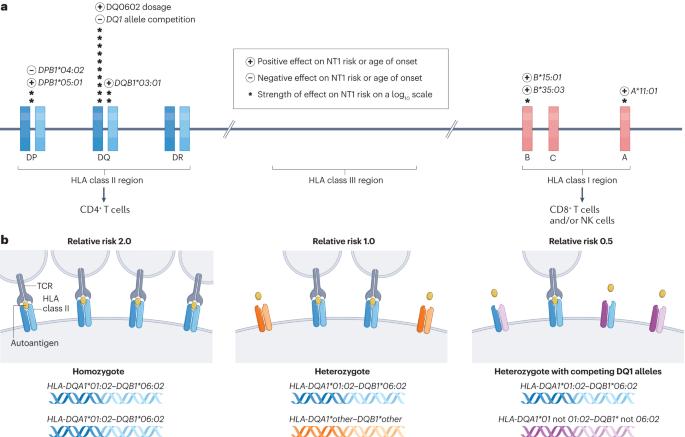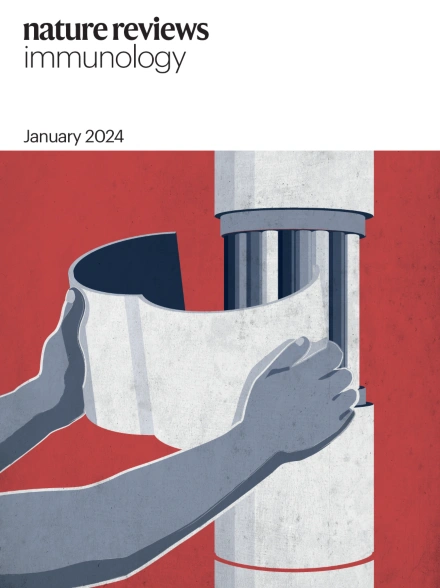1 型嗜睡症的免疫发病机制。
IF 67.7
1区 医学
Q1 IMMUNOLOGY
引用次数: 5
摘要
1 型嗜睡症(NT1)是一种慢性睡眠障碍,是由于一小部分下丘脑神经元缺失导致的,这些神经元能产生促进唤醒的视网膜下视素(HCRT,又称奥曲肽肽)。鉴于 NT1 与 MHC II 类等位基因 HLA-DQB1*06:02 的紧密联系,以及最近的遗传学证据显示与 T 细胞受体基因的多态性和其他免疫相关位点的联系,以及在接种流感疫苗 Pandemrix 后观察到的 NT1 发病率的增加,人们长期以来一直怀疑 NT1 是一种免疫介导的病理现象。目前正在寻找 NT1 致病性 T 细胞反应所识别的自身抗原和外来抗原。不断有报告称,NT1 患者的 T 细胞对 HCRT 的反应性增高,但目前还缺乏证明 T 细胞在神经元破坏中起主要作用的数据。动物模型为自反应性 CD4+ 和 CD8+ T 细胞在疾病中的作用提供了线索。阐明 NT1 的发病机理将有助于在发病初期开发有针对性的免疫疗法,并可作为其他免疫介导的神经系统疾病的模型。本文章由计算机程序翻译,如有差异,请以英文原文为准。

The immunopathogenesis of narcolepsy type 1
Narcolepsy type 1 (NT1) is a chronic sleep disorder resulting from the loss of a small population of hypothalamic neurons that produce wake-promoting hypocretin (HCRT; also known as orexin) peptides. An immune-mediated pathology for NT1 has long been suspected given its exceptionally tight association with the MHC class II allele HLA-DQB1*06:02, as well as recent genetic evidence showing associations with polymorphisms of T cell receptor genes and other immune-relevant loci and the increased incidence of NT1 that has been observed after vaccination with the influenza vaccine Pandemrix. The search for both self-antigens and foreign antigens recognized by the pathogenic T cell response in NT1 is ongoing. Increased T cell reactivity against HCRT has been consistently reported in patients with NT1, but data demonstrating a primary role for T cells in neuronal destruction are currently lacking. Animal models are providing clues regarding the roles of autoreactive CD4+ and CD8+ T cells in the disease. Elucidation of the pathogenesis of NT1 will allow for the development of targeted immunotherapies at disease onset and could serve as a model for other immune-mediated neurological diseases. This article reviews growing evidence suggesting that narcolepsy, a chronic sleep disorder caused by deficiency of hypocretin (also known as orexin), has an immune-mediated basis, explores the potential role of autoreactive lymphocytes in the disease process, and proposes future research directions to elucidate its pathogenesis.
求助全文
通过发布文献求助,成功后即可免费获取论文全文。
去求助
来源期刊

Nature Reviews Immunology
医学-免疫学
CiteScore
93.40
自引率
0.40%
发文量
131
审稿时长
6-12 weeks
期刊介绍:
Nature Reviews Immunology is a journal that provides comprehensive coverage of all areas of immunology, including fundamental mechanisms and applied aspects. It has two international standard serial numbers (ISSN): 1474-1733 for print and 1474-1741 for online. In addition to review articles, the journal also features recent developments and new primary papers in the field, as well as reflections on influential people, papers, and events in the development of immunology. The subjects covered by Nature Reviews Immunology include allergy and asthma, autoimmunity, antigen processing and presentation, apoptosis and cell death, chemokines and chemokine receptors, cytokines and cytokine receptors, development and function of cells of the immune system, haematopoiesis, infection and immunity, immunotherapy, innate immunity, mucosal immunology and the microbiota, regulation of the immune response, signalling in the immune system, transplantation, tumour immunology and immunotherapy, and vaccine development.
 求助内容:
求助内容: 应助结果提醒方式:
应助结果提醒方式:


